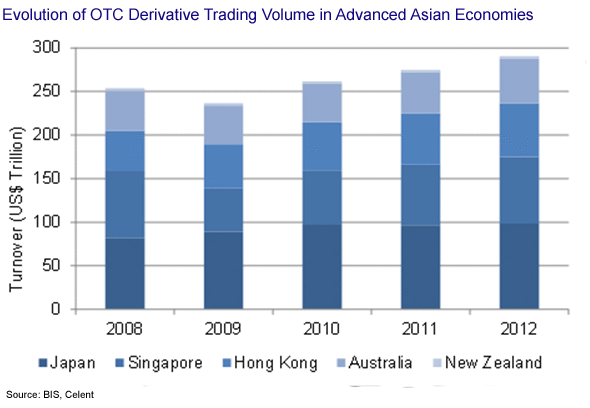OTC Derivatives in the Advanced Asian Economies
Australia, Hong Kong, Japan, New Zealand, Singapore
Abstract
The Asian OTC derivatives market is small compared to the global market. The market is dominated by five advanced economies: Australia, Hong Kong, Japan, New Zealand, and Singapore, which account for over 90% of OTC derivatives trading volume in Asia and reached US$290 trillion in 2012.
In the report, OTC Derivatives in the Advanced Asian Economies, Celent analyzes the state of the OTC derivatives markets in the advanced Asian countries, all of which have developed economies, mature financial services markets, larger integration with global financial markets, and relatively open regulatory regimes allowing foreign participation in domestic markets. The Asian financial market, unlike its western counterparts, is not homogeneous. Rather, countries are divided along jurisdictional lines with limited regional integration. Asia has a large number of countries at different levels of economic development, but the countries also have different regulatory and monetary regimes. This has resulted in a number of highly localized markets, with the exception of a few, notably Hong Kong and Singapore.
Trading volume in the advanced Asian economies declined by 6.7% in 2009 as a result of the global financial crisis. However, the market has been recovering since then, growing at a 7.1% CAGR from 2009 to 2012. Foreign exchange derivatives are the dominant asset class in these five leading countries, accounting for 72% of total trading volume in these countries. Interest rate derivatives are a distant second, with a 17% share in total trading volume. Other asset classes are not significant in Asia, even though commodity derivatives are growing rapidly — especially in Singapore.

“Driven by regulatory changes, central clearing and trade repository will become business opportunities for new revenue stream for some participants,” says Arin Ray, Analyst with Celent’s Securities & Investments Group and author of the report. “Given exchanges’ dominant role in the Asian markets, domestic exchanges have taken the lead in trying to capture market share in this area. However, the proliferation of too many CCPs, with many having low volumes, may make some of them economically unviable.”
This report examines developments related to OTC derivatives market reforms in Asia, and analyzes the implications and challenges for market participants. The report also analyzes issues and trends at the national level for each of the five advanced countries.

